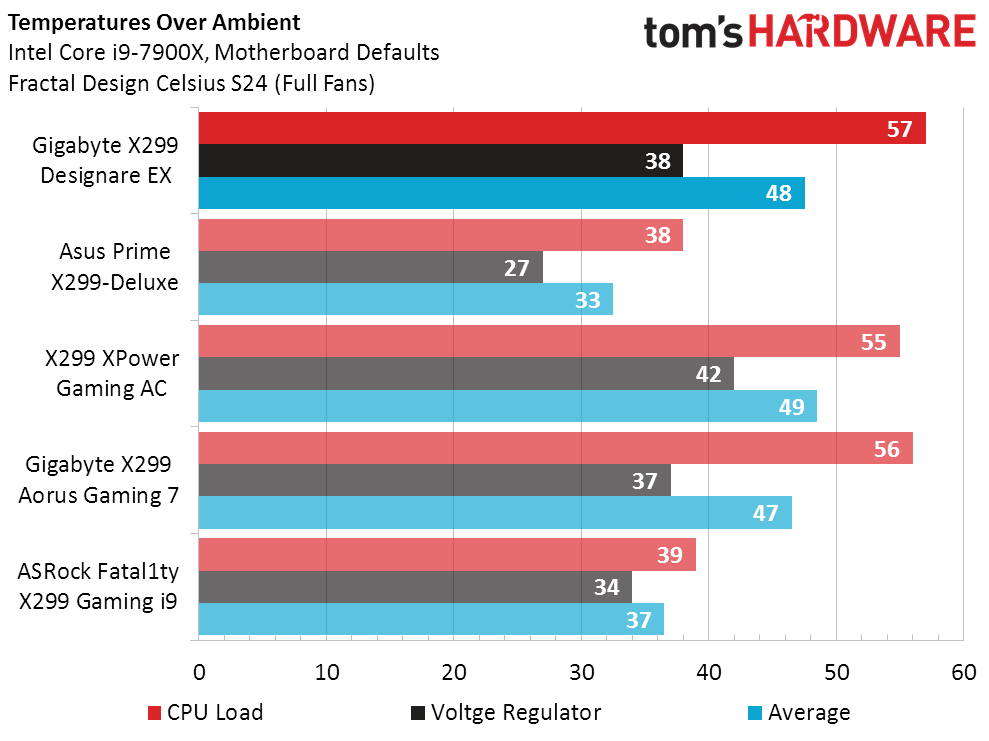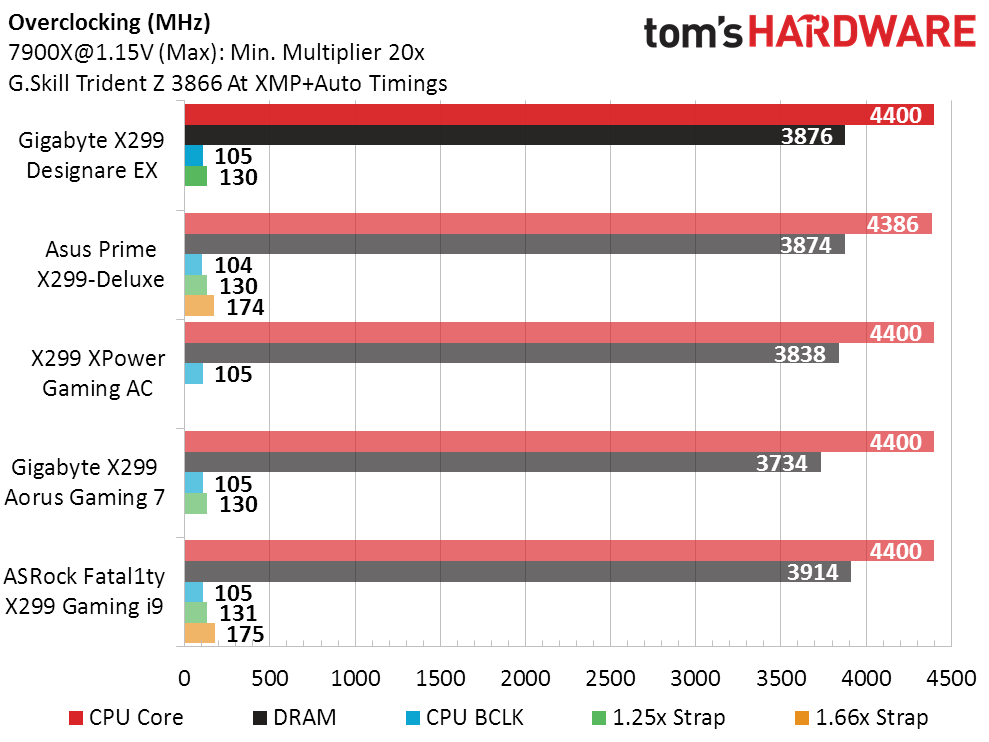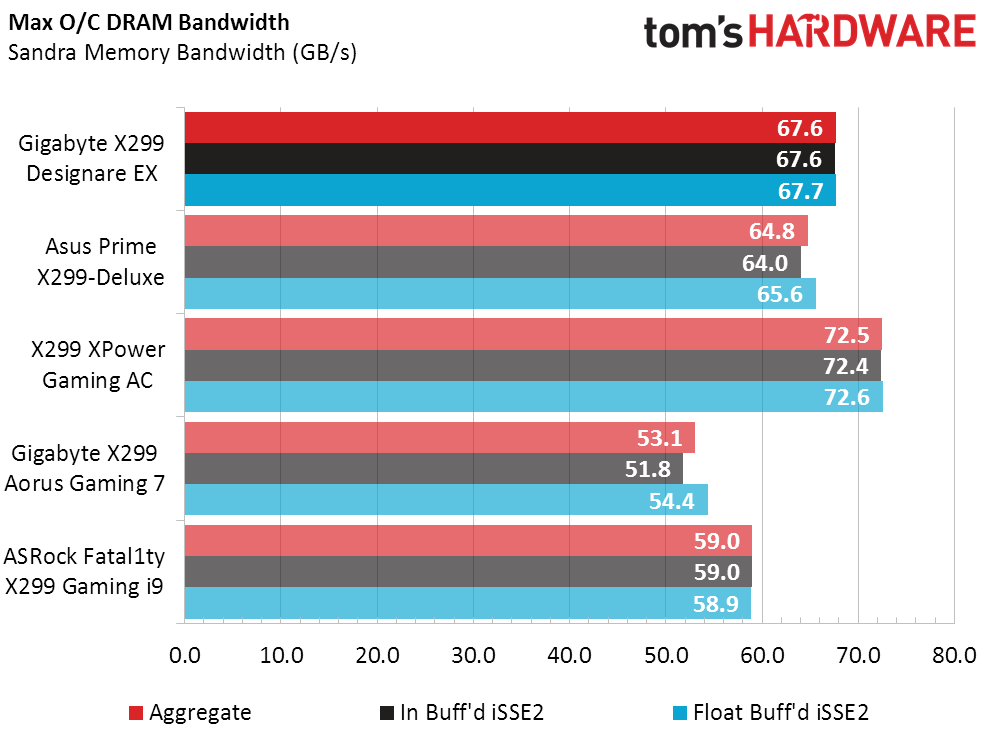Gigabyte X299 Designare EX ATX Motherboard Review: Solid OC, Plus Thunderbolt 3
Why you can trust Tom's Hardware
Benchmark Results & Final Analysis
We start with synthetic benchmarks, which are typically used to diagnose performance problems or the benefits of specific hardware changes. Intel has standardized its platform to the extent that the fairest comparison will yield unnoticeable performance differences.
Synthetic Benchmarks

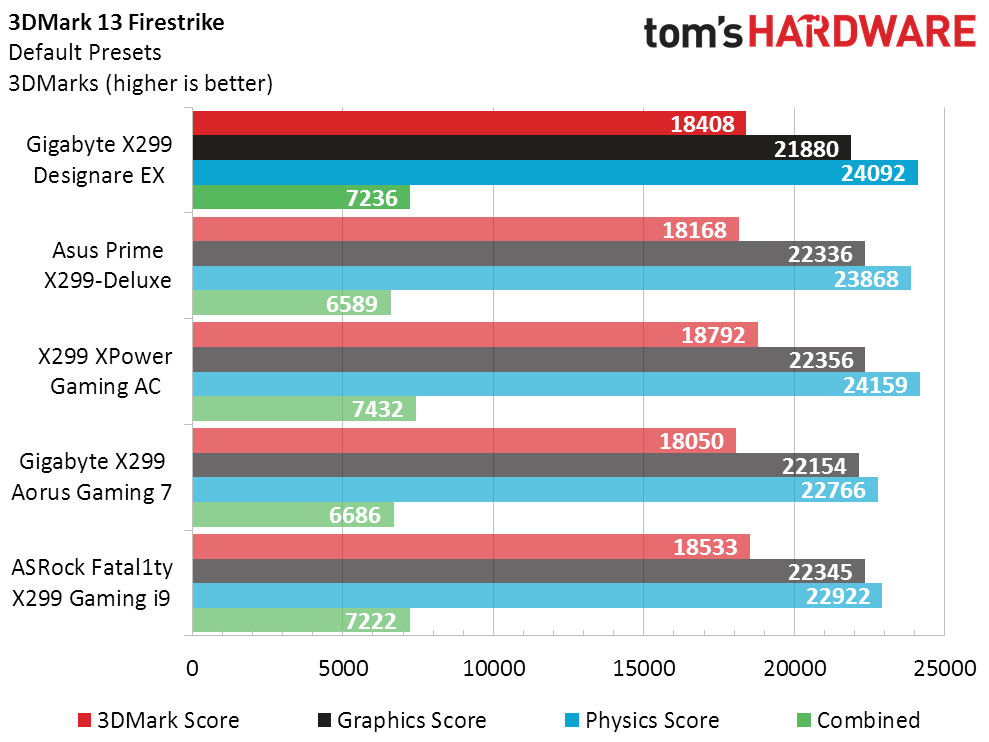



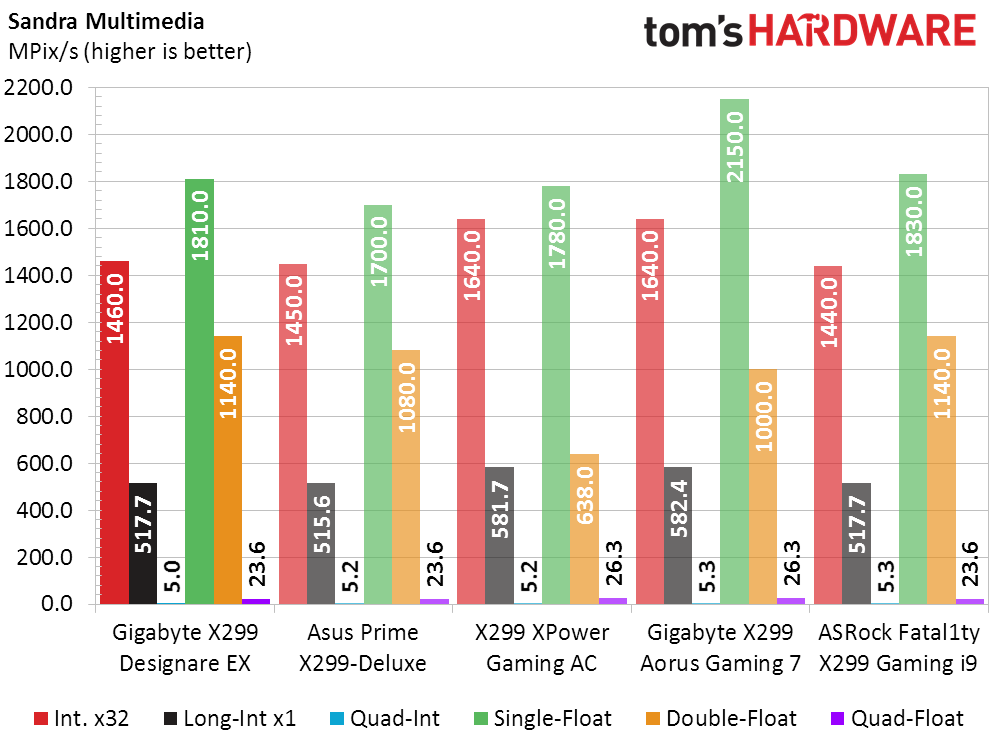

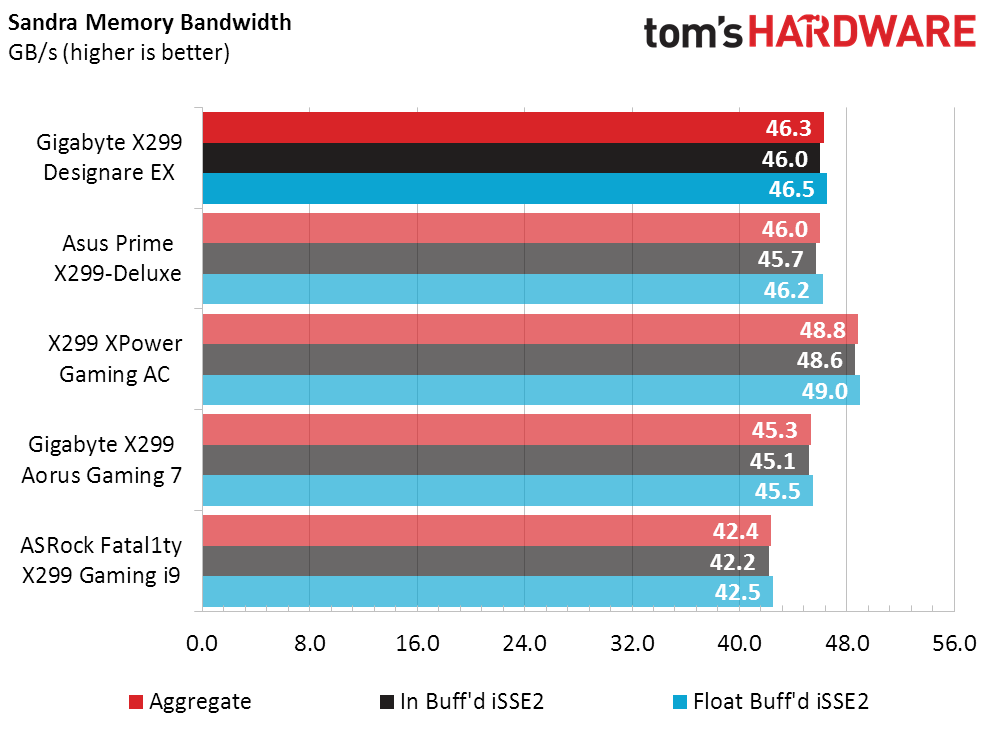
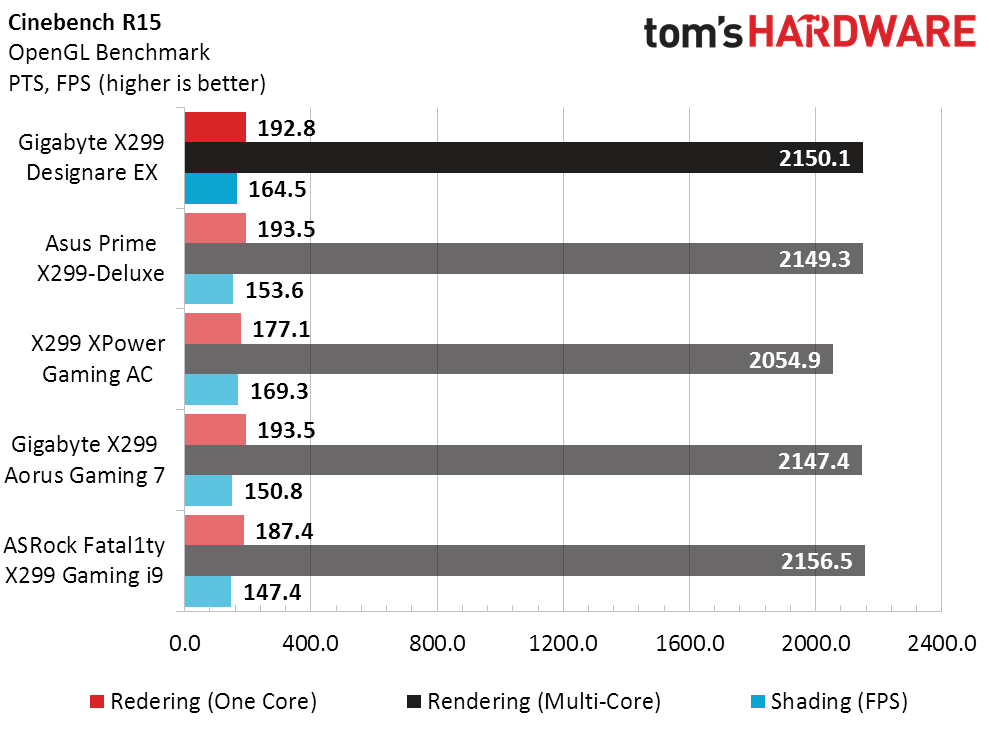
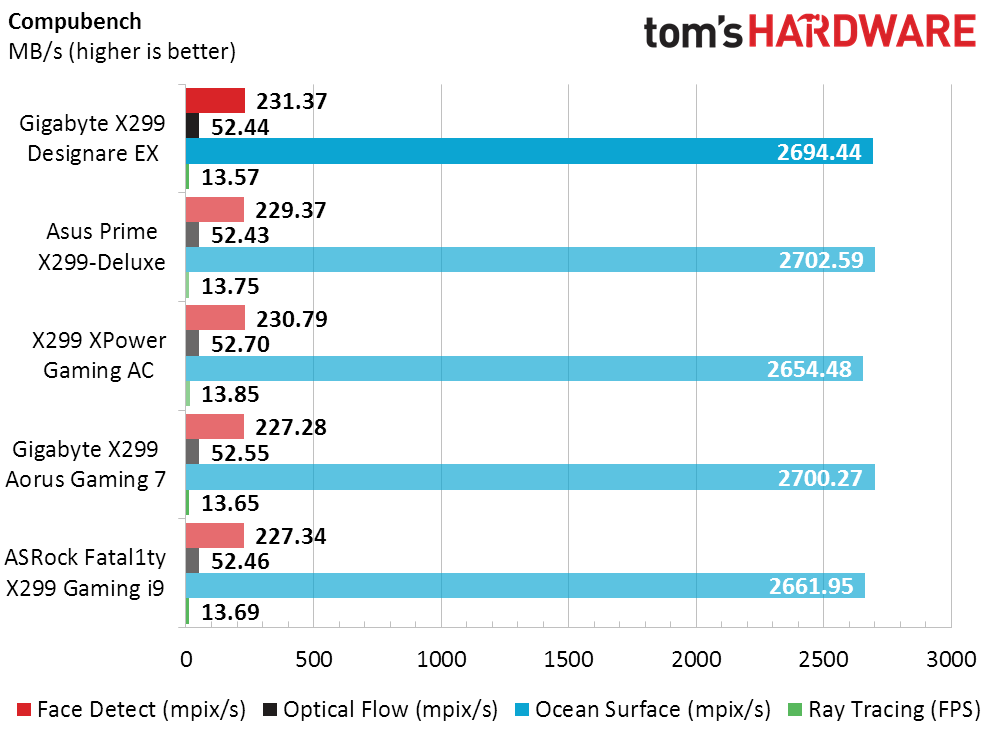
The X299 Designare EX slides through our synthetic tests without missing a beat, coming out completely average in a suite where standing out is usually a bad thing.
3D Games
The F1 2015 test revealed one stand-out result, which isn’t unusual except that on the X299 Designare EX, that high result wasn’t offset in the averages by a low result. At this point, it appears the game’s Ultra setting occasionally produces outliers, and the newer Gigabyte board is simply the surprise beneficiary.

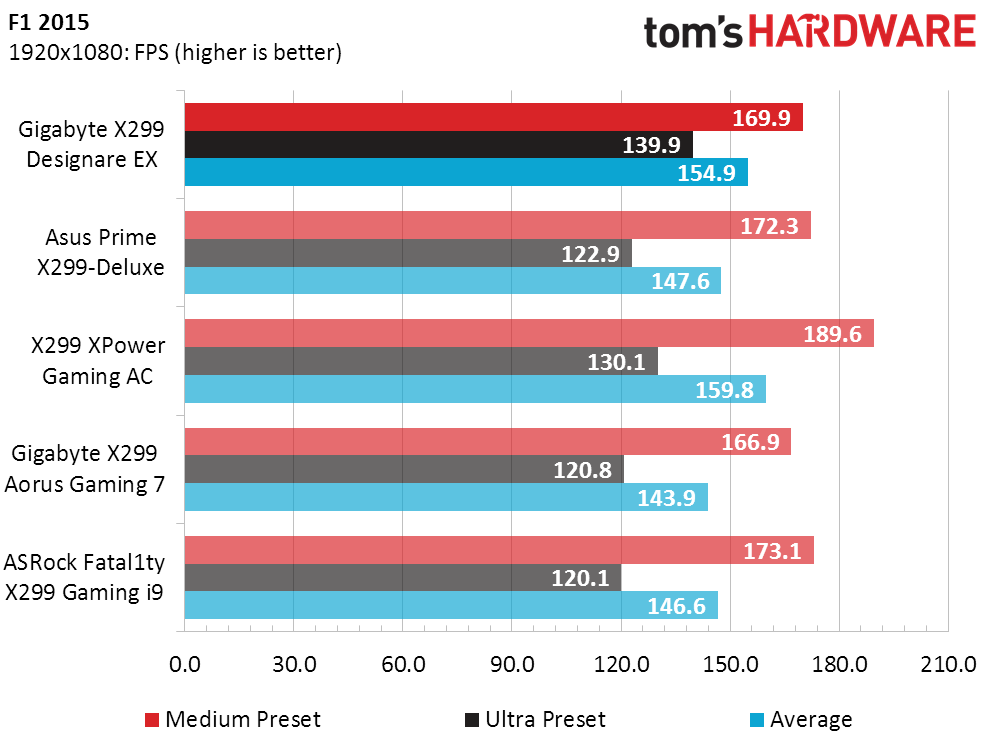

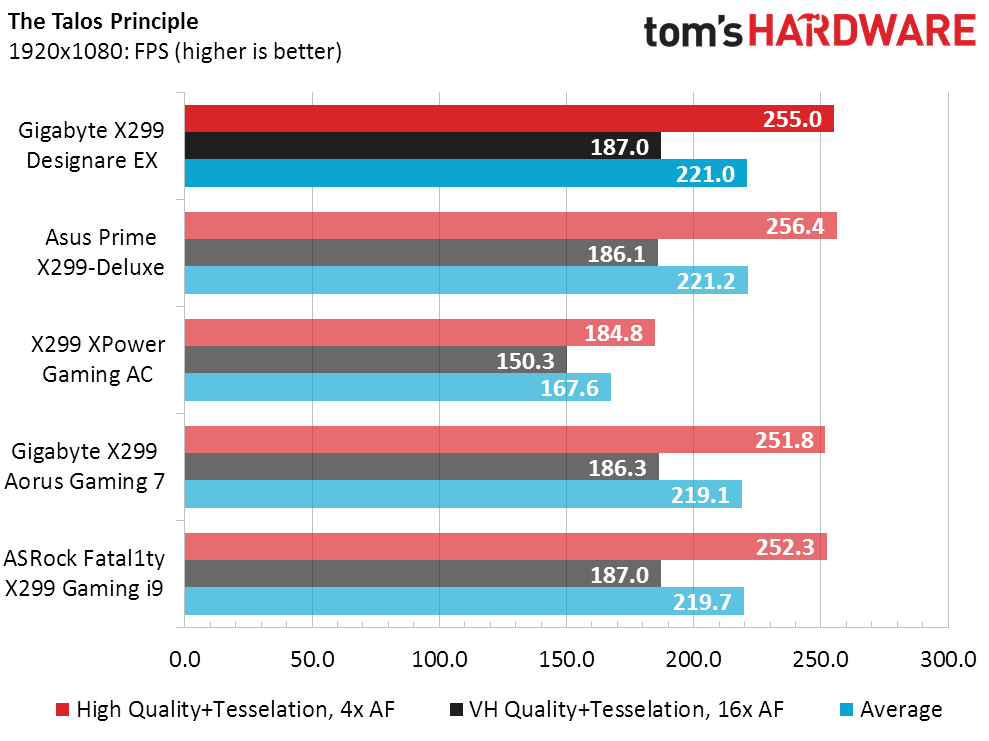
The X299 Designare EX is otherwise unexceptional, which again is usually a good thing when all the underlying hardware (CPU, DRAM, GPU) is unchanged. The X299 XPower Gaming AC fell behind in Talos due to the overhead of an included program that’s Talos-compatible, and its review produced a chart that shows its performance with the same program disabled.
Timed Applications
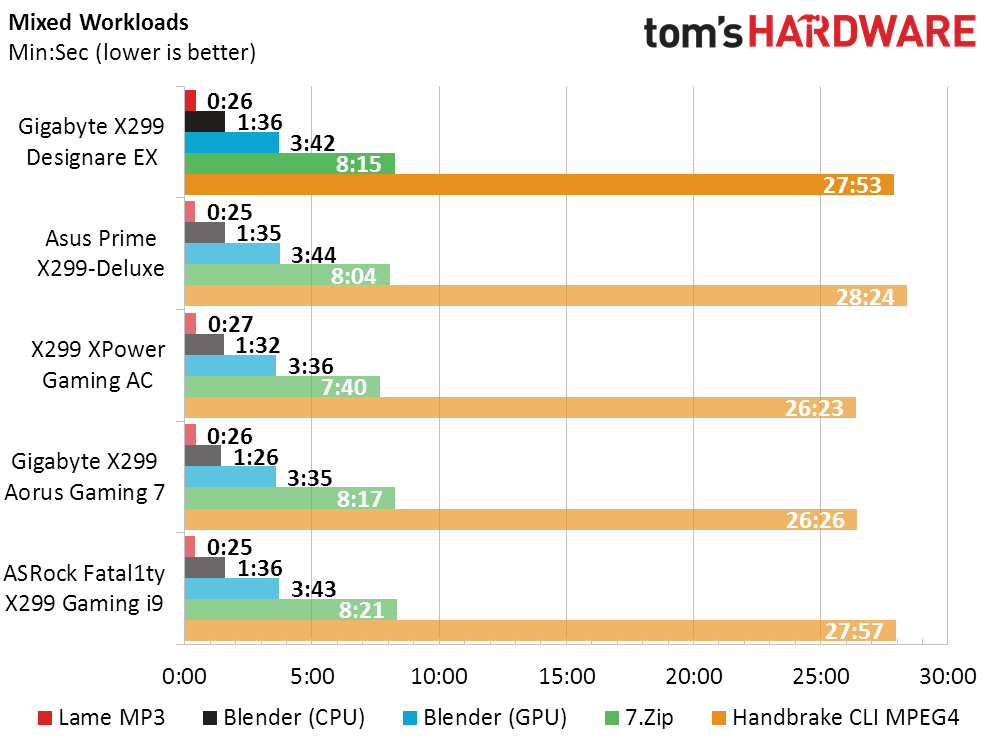
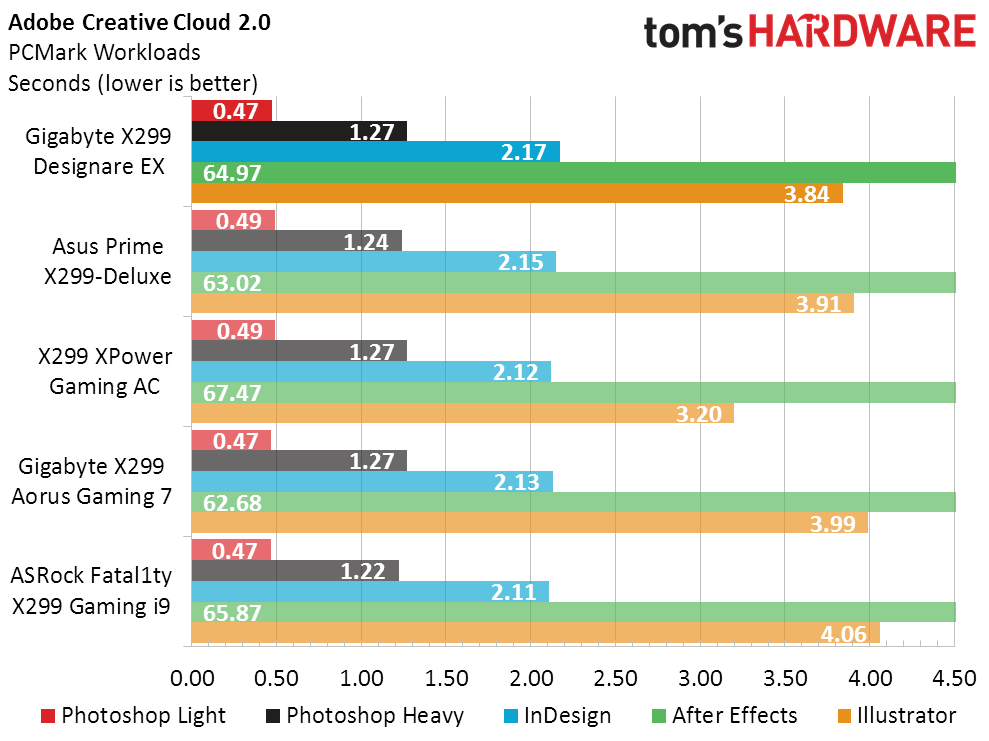

The X299 Designare EX looks as average in our timed applications as it has in the other benchmarks. So, how does an honest board look in power, heat, and overclocking?
Power, Heat & Efficiency
The X299 Designare EX allowed our complete system to consume 246W fully loaded by default, appearing to follow the standards of voltage-regulated efficiency set by the Asus X299 Deluxe and the Fatal1ty X299 Gaming i9. Yet Intel XTU showed current limit throttling to 3.6GHz, where the competing boards were hitting 4GHz, and changing the firmware’s “Package Power Limits” from the default 140W to anything higher didn’t appear to have any effect. (Core Current Limit is already maxed by default.) Overclocking disabled this feature, but to get “stock” readings at 4GHz, we had to manually key the stock Turbo Boost multipliers for our CPU into the firmware.
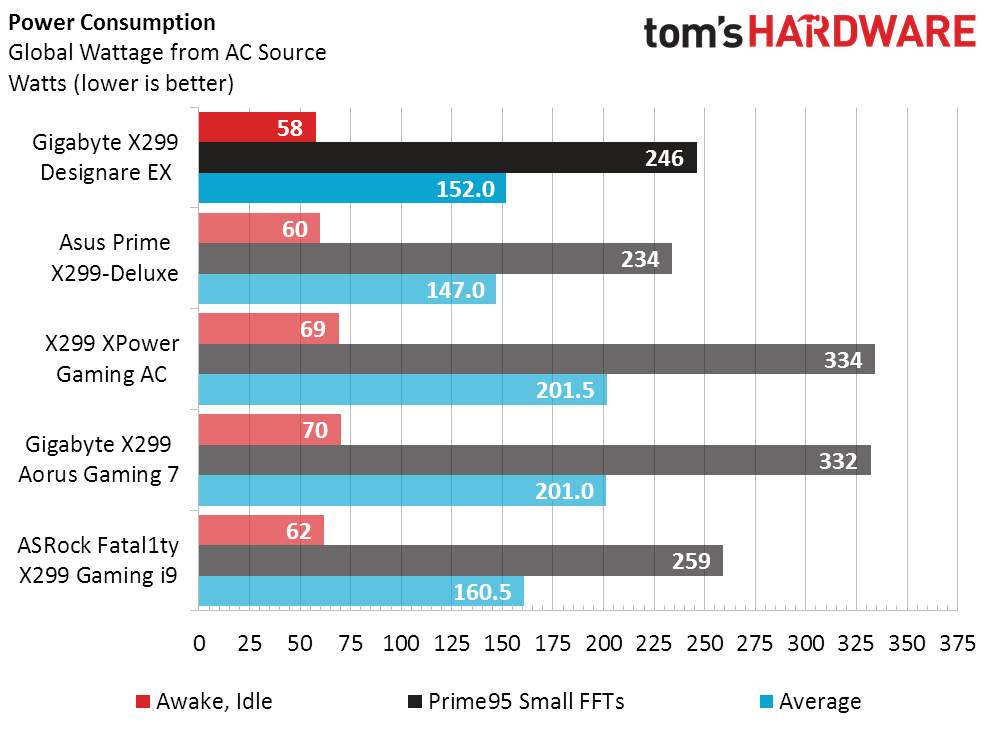
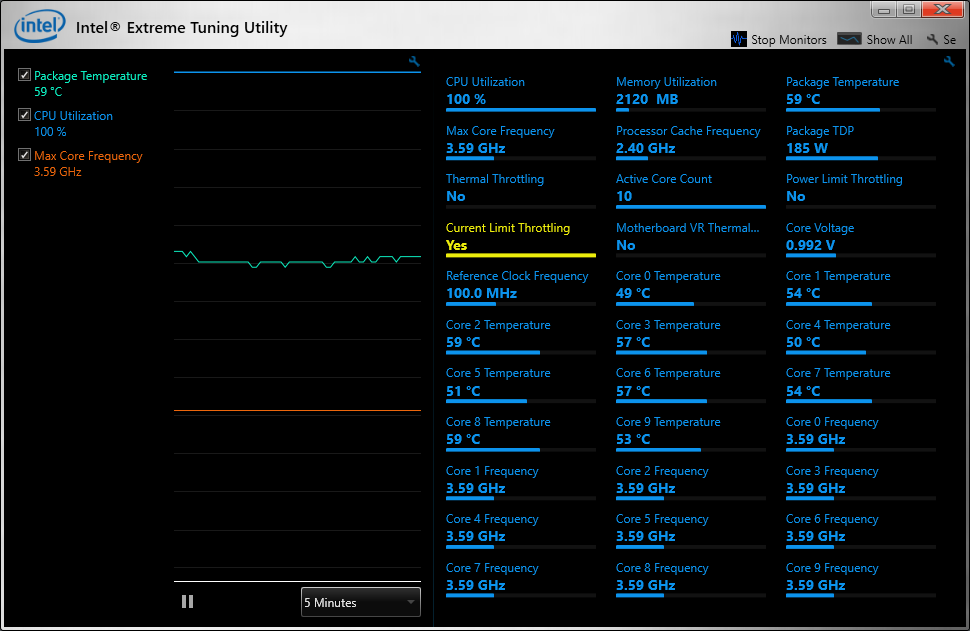
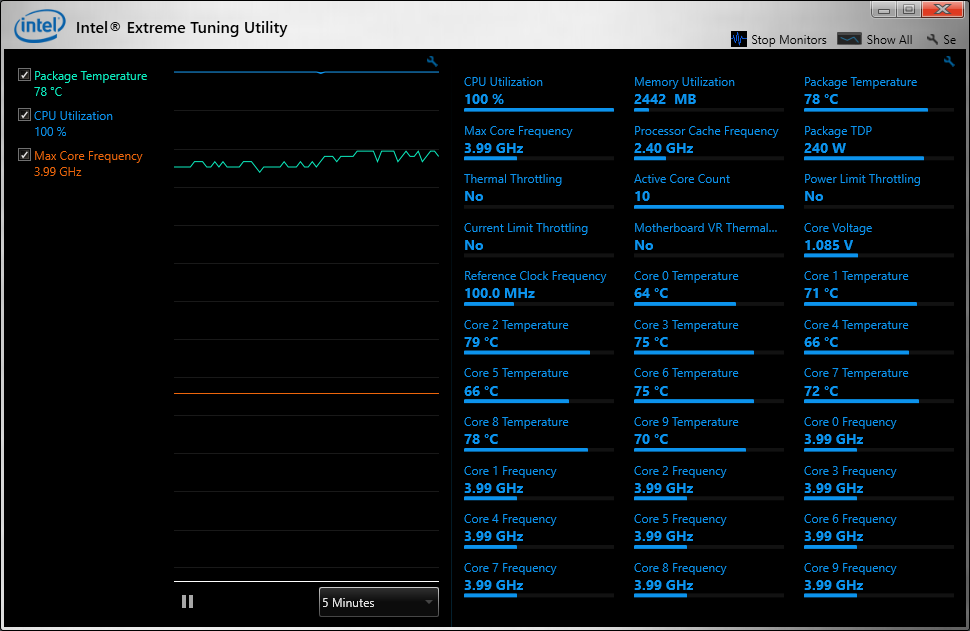
While manual configuration of “CPU default multipliers” got us back to the same full-load frequency as the other boards, it also caused power use to increase from 246W to 324W. The CPU core temperature also climbed from 39 to 57°C and the voltage regulator from 49 to 59°C, over ambient. No wonder these companies don’t want us to use Prime95 small-FFTs!
Get Tom's Hardware's best news and in-depth reviews, straight to your inbox.
Thanks in part to the presence of a similar board, the X299 Designare EX falls mid-pack in efficiency (our overall performance and power numbers are an average of all X299 motherboards tested, including those not used in today’s charts).
Overclocking
When we started testing X299 motherboards, we didn’t have enough products to compare additional boot straps. Those results were attained but not used until today. I personally didn’t know that they’d ever be relevant to the majority of overclockers. Without those numbers, the X299 Designare EX looks like a completely competent overclocker. So if the higher boot straps aren’t important, why bring them up now?
The X299 Designare EX became unresponsive while trying to overclock using the 1.66x boot strap, and “CLR_CMOS” didn’t fix it completely. It booted into Windows but hung. I tried everything including the slow drain and reflashing to different firmware revisions to get the board stable. The next time I was able to enter Windows, Gigabyte’s firmware flashing utility popped up. Since the system still wasn’t completely stable, I gave that a go. It hung at the point where it said “Rebooting in 5 seconds”. Windows wouldn’t load after that, and even Windows PE would crash. Fortunately, I found the solution.
You’re not going to believe this. Thinking that a part of the firmware that wasn’t being cleared was probably retaining some of the wrong settings for the 1.66x boot strap, I keyed a 101MHz BCLK into the board’s M.I.T. menu. The board made all the necessary changes for a 101MHz BCLK, and everything was stable once again. Remember, the crash had caused the system to hang even at firmware defaults, and only a manual overclock would force it to choose the right complimentary settings on its own. FYI for anyone who encounters the same bug: You're welcome.
Performance is the point of overclocking, and the X299 Designare EX takes second place out of five high-end boards in overclocked DRAM performance.
Final Thoughts
Gigabyte’s X299 Designare EX is the only comparison board to include Intel Thunderbolt 3, so a price-to-performance comparison might not even be justified within its own price class. On the other hand, the last time I checked, an onboard Thunderbolt 3 controller was roughly a $40 feature, and the Designare EX costs only $50 more than the Gaming 7.
Alternatively, the Aorus Gaming 7 includes two more of ASMedia’s high-end USB 3.1 Gen2 controllers. And the last time I checked, one of those PCIe 3.0 x2 to dual-port USB 3.1 Gen1 controllers onboard was approximately a $20 feature. That’s probably why I questioned the lack of Thunderbolt 3 on the Gaming 7.
So, the X299 Designare EX is a fine board from a features standpoint and a solid overclocker worthy at least of an informal stamp of approval. Would I choose this over MSI’s X299 XPower Gaming AC? That would probably depend on whether or not someone handed me a bunch of Thunderbolt 3 devices...
MORE: Best Motherboards
MORE: How To Choose A Motherboard
MORE: All Motherboard Content
-
AnimeMania I don't know a lot about computers, but I am totally confused by this motherboard's video inputs/outputs. I know that since this is a gaming motherboard, a graphics card with normal video ports would also be installed. DP IN wouldn't motherboards normally be DP Out, would you connect the video card's DP OUT to the Motherboard's DP IN and use Thunderbolt to display graphics? Where are the standards like HDMI, shouldn't you have some type of video out to test that the motherboard is functioning properly? Will all motherboards be heading towards these types of configurations?Reply -
erickmendes ThunderBolt 3: GIGABYTE is using Intel's new ThunderBolt 3 controller which offers two ThunderBolt 3 ports. The reason we have two DisplayPort input jacks on the rear IO is that ThunderBolt 3 requires a Display Port signal, so you would hook those up to your GPU if you want to use ThunderBolt 3. It has to be this way on every motherboard without integrated graphics, that's one reason you don't see ThunderBolt 3 on many X299 motherboards. The TB3 type-C ports double as USB and DP type-C ports, and the power delivery ICs should provide a lot of power.Reply
Read more: https://www.tweaktown.com/reviews/8483/gigabyte-x299-designare-ex-intel-motherboard-review/index11.html -
straifejacket gigabyte's own docs and config tool say the board can only do 8x/16x/8x, presumably because they needed some PCIe lanes for thunderbolt.Reply
what led you to the conclusion it supports 16x/16x/8x? -
Crashman Reply
You're thinking along the lines of boards that use the CPU's integrated graphics, such as the Z370 series. X299 uses certain Xeons as well as desktop CPUs based on re-specified Xeons, none of which have in integrated GPU. So you're wondering "Why then does it have video connectors?"20817759 said:I don't know a lot about computers, but I am totally confused by this motherboard's video inputs/outputs. I know that since this is a gaming motherboard, a graphics card with normal video ports would also be installed. DP IN wouldn't motherboards normally be DP Out, would you connect the video card's DP OUT to the Motherboard's DP IN and use Thunderbolt to display graphics? Where are the standards like HDMI, shouldn't you have some type of video out to test that the motherboard is functioning properly? Will all motherboards be heading towards these types of configurations?
Thunderbolt 3 supports video AND data transmission, but the onboard Thunderbolt 3 controller only transmits data. Gigabyte must then rely on the builder's choice of graphics card to make Thunderbolt 3 monitors and Thunderbolt 3 external drives/etc daisy chain together. And so it has graphics input, for your graphics card, and passes that signal through to the Thunderbolt ports. The next guy finishes that discussion.
Thanks for the description. I told him what he needed to know in order to understand what you were telling him. It was pretty easy, without need to link an external site ;)20817916 said:ThunderBolt 3: GIGABYTE is using Intel's new ThunderBolt 3 controller which offers two ThunderBolt 3 ports. The reason we have two DisplayPort input jacks on the rear IO is that ThunderBolt 3 requires a Display Port signal, so you would hook those up to your GPU if you want to use ThunderBolt 3. It has to be this way on every motherboard without integrated graphics, that's one reason you don't see ThunderBolt 3 on many X299 motherboards. The TB3 type-C ports double as USB and DP type-C ports, and the power delivery ICs should provide a lot of power.
I would like to thank you for pointing this out: I appended some data in the table, and then used the table to guide my discussion.20818226 said:gigabyte's own docs and config tool say the board can only do 8x/16x/8x, presumably because they needed some PCIe lanes for thunderbolt.
what led you to the conclusion it supports 16x/16x/8x?
But, I'd also like to point out that the board can do x8/x8/x8 on a 28-lane CPU. So, using Thunderbolt as an excuse for only being able to do x8/x16/x8 on a 44-lane CPU is rather weak: A 44 lane CPU has 16 more lanes than a 28-lane CPU, not 8. So thanks for your help, and shame on Gigabyte for not being forthright in its explanation. -
Saga Lout Sorry, Crashman. The Development Team are working on some Forum foibles and that sort of problem is coming to an end.Reply
